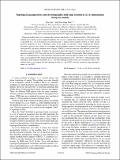Topological quasiparticles and the holographic bulk-edge relation in (2+1)-dimensional string-net models
Author(s)
Lan, Tian; Wen, Xiao-Gang
DownloadPhysRevB.90.115119.pdf (2.877Mb)
PUBLISHER_POLICY
Publisher Policy
Article is made available in accordance with the publisher's policy and may be subject to US copyright law. Please refer to the publisher's site for terms of use.
Terms of use
Metadata
Show full item recordAbstract
String-net models allow us to systematically construct and classify (2+1)-dimensional [(2+1)D] topologically ordered states which can have gapped boundaries. We can use a simple ideal string-net wave function, which is described by a set of F-matrices [or more precisely, a unitary fusion category (UFC)], to study all the universal properties of such a topological order. In this paper, we describe a finite computational method, Q-algebra approach, that allows us to compute the non-Abelian statistics of the topological excitations [or more precisely, the unitary modular tensor category (UMTC)], from the string-net wave function (or the UFC). We discuss several examples, including the topological phases described by twisted gauge theory [i.e., twisted quantum double D[superscript α](G)]. Our result can also be viewed from an angle of holographic bulk-boundary relation. The (1+1)-dimensional [(1+1)D] anomalous topological orders, that can appear as edges of (2+1)D topological states, are classified by UFCs which describe the fusion of quasiparticles in (1+1)D. The (1+1)D anomalous edge topological order uniquely determines the (2+1)D bulk topological order (which are classified by UMTC). Our method allows us to compute this bulk topological order (i.e., the UMTC) from the anomalous edge topological order (i.e., the UFC).
Date issued
2014-09Department
Massachusetts Institute of Technology. Department of PhysicsJournal
Physical Review B
Publisher
American Physical Society
Citation
Lan, Tian, and Xiao-Gang Wen. "Topological quasiparticles and the holographic bulk-edge relation in (2+1)-dimensional string-net models." Phys. Rev. B 90, 115119 (September 2014). © 2014 American Physical Society
Version: Final published version
ISSN
1098-0121
1550-235X